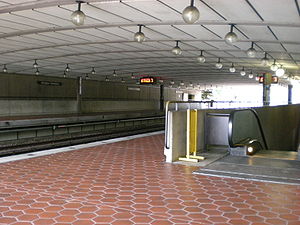Arlington Cemetery station
Arlington Cemetery | |||||||||||
|---|---|---|---|---|---|---|---|---|---|---|---|
 | |||||||||||
| General information | |||||||||||
| Location | 1000 North Memorial Drive, Arlington, Virginia | ||||||||||
| Coordinates | 38°53′4.5″N 77°3′47.1″W / 38.884583°N 77.063083°W | ||||||||||
| Owned by | WMATA | ||||||||||
| Platforms | 2 side platforms | ||||||||||
| Tracks | 2 | ||||||||||
| Construction | |||||||||||
| Structure type | Open-cut | ||||||||||
| Accessible | Yes | ||||||||||
| Other information | |||||||||||
| Station code | C06 | ||||||||||
| History | |||||||||||
| Opened | July 1, 1977 | ||||||||||
| Passengers | |||||||||||
| 2017 | 1,476 daily [1] | ||||||||||
| Services | |||||||||||
| |||||||||||
| |||||||||||
Arlington Cemetery is a side platformed Washington Metro station in Arlington, Virginia, United States. The station was opened on July 1, 1977, and is operated by the Washington Metropolitan Area Transit Authority (WMATA). The station provides service for only the Blue Line, and is located at the entrance to Arlington National Cemetery, underneath Memorial Drive. There is no public parking near the station except at the cemetery, which is reserved for cemetery visitors. It is the only station that closes earlier than the rest of the system, closing at 7 PM from October to March, and 10 PM from April to September.[2]
The station is one of three stations to be exclusively serviced by the Blue Line. The rest of the Blue Line's stations are shared with the Yellow Line to the south (except for two of the southernmost stations), and with the Silver Line and Orange Line to the north.
Since March 26, 2020, this station has been closed until further notice due to the 2020 coronavirus pandemic.[3][4]
History

The station opened on July 1, 1977.[5] Its opening coincided with the completion of 11.8 miles (19.0 km)[6] of rail between National Airport and RFK Stadium and the opening of the Capitol South, Crystal City, Eastern Market, Farragut West, Federal Center SW, Federal Triangle, Foggy Bottom–GWU, L'Enfant Plaza, McPherson Square, National Airport, Pentagon, Pentagon City, Potomac Avenue, Rosslyn, Smithsonian, and Stadium–Armory stations.[7]
In May 2018, Metro announced an extensive renovation of platforms at twenty stations across the system. The platforms at the Arlington Cemetery station would be rebuilt in September 2021.[8]
Station layout
Arlington Cemetery is unique in its design, located just below ground level and only covered by a bridge carrying Memorial Drive. Escalators from Memorial Drive go down two levels to the mezzanine, where customers may purchase SmarTrip cards at vending machines and pass through fare control. Escalators on the other side of fare control then go up to the side platforms. Elevators go directly to the platforms with one fare gate for each elevator at platform level.
| G | Street level | Exit/entrance |
| P Platform level |
Side platform | |
| Southbound | ← | |
| Northbound | | |
| Side platform | ||
| M | Mezzanine | Fare control, ticket machines, station agent |
Notable places nearby
- Arlington House (also known as the Custis-Lee Mansion)
- Arlington Memorial Bridge
- Arlington National Cemetery
- Lincoln Memorial
- Tomb of the Unknown Soldier
- Women in Military Service for America Memorial
References
- ^ "Metrorail Average Weekday Passenger Boardings" (PDF). WMATA. Retrieved July 31, 2018.
- ^ "Arlington Cemetery". WMATA. Retrieved March 27, 2018.
- ^ "Special Covid-19 System Map" (PDF). Washington Metropolitan Area Transit Authority. Retrieved May 24, 2020.
- ^ "Metrorail stations closed due to COVID-19 pandemic". Washington Metropolitan Area Transit Authority. March 23, 2020. Retrieved May 24, 2020.
- ^ Feaver, Douglas B. (July 1, 1977). "Today, Metro could be U.S. model". The Washington Post. p. A1.
- ^ "Sequence of Metrorail openings" (PDF). Washington Metropolitan Area Transit Authority. 2017. p. 3. Archived from the original (PDF) on July 2, 2018. Retrieved March 27, 2018.
- ^ "Metro's newest stations: Where they are, what's nearby". The Washington Post. June 24, 1977.
- ^ "Metro wants to rebuild 20 station platforms over three years, creating SafeTrack-like disruptions". Washington Post. May 7, 2018. Retrieved February 19, 2019.
External links
 Media related to Arlington Cemetery (WMATA station) at Wikimedia Commons
Media related to Arlington Cemetery (WMATA station) at Wikimedia Commons
- The Schumin Web Transit Center: Arlington Cemetery Station
- Memorial Drive entrance from Google Maps Street View

